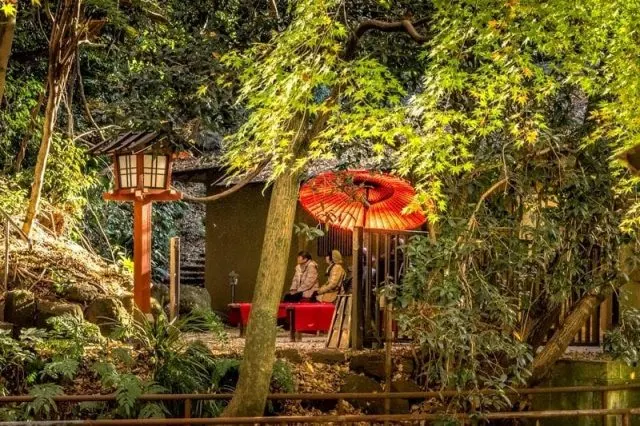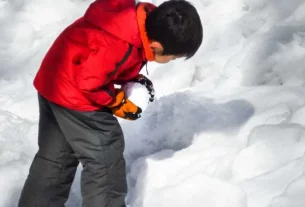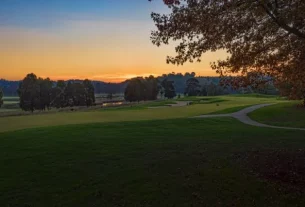Looking for a different Tokyo experience? Take a short train ride out to Todoroki Gorge and explore the unique natural wilderness and only ravine of the city. It’s a completely different experience and not what you’d expect in the heart of the modern metropolitan city.

As much as we love visiting Tokyo and Japan’s other major cities including Osaka and Kyoto, we aren’t naturally big city people and find after a few days that the pace takes its toll and we need to break up our stay with a day trip out to a smaller town or nature space.
I had this in mind as I suggested we head out to Todoroki Gorge after a delicious sushi breakfast and explore Tokyo’s fun but intensely busy fish market. We stayed at Tokyo Park Hotel on this trip which is an equally easy walk to the Tsukiji fish market and surrounding restaurants as it is to the trendy cafes and high-end restaurants of Ginza.
Shiodome itself also has an amazing selection of local eateries making it an ideal base for the foodie. How good does this sashimi bowl look? It was so FRESH and delicious.
How to get to Todoroki Gorge
Todoroki is in central Tokyo so it’s ideal to escape for a couple of hours or spend a little longer and investigate the wider area as a day trip.
To get there you need to head to Todoroki station southwest of the city centre. It’s about 15 minutes from Shibuya on the Tokyu Oimachi Line and will cost Y200-Y400 depending on your starting point in the city. You may need to transfer from a subway line but it’s straightforward with the Tokyo subway and train signs being in both Japanese and English.
Three other articles you may find useful in finding your way around Japan are our top tips for transport in Japan, mastering the Tokyo subway like a local and everything you need to know about the JR Pass including when NOT to buy it.
To find the quickest and simplest route on Japan’s public transport system I use the free website resource Hyperdia. Simply plug in the destination station “Todoroki(Tokyo)” and departure point to find the best options.
You can download the app in Japan but I find the English version very glitchy so I stick to using the website on my phone. I usually use the extra options if I’m going somewhere less mainstream or on a long-distance trip and select the sort order as ‘transfer’. This gives the simplest routes with less swapping between lines and I rarely find it makes more than a couple of minutes difference.
There are a couple of cafes and several restaurants very close to the station if you want to plan lunch or refreshments before your walk. The start of the gorge path is only a 3-minute walk south of the station.
Explore Todoroki Gorge
Todoroki is the only gorge in all 23 city wards of central Tokyo and offers a contrast to the beautifully manicured gardens of the city. Despite being so easy to access it has a wonderful secret wilderness feel to it especially if you have the flexibility as we did to plan a mid-week visit. I’ve heard it can become quite busy on the weekends and while the beauty would be unchanged it was pretty special being there when it was so quiet that all you could hear most of the time was bird song and the running water in the stream.
We joined the walking path at Golf-bashi bridge, a distinctive red bridge that marks the starting point of the walking track through the valley beside the Yazawa river. There are stairs down to the Yazawa river at this point and at several of the detours such as up to the temple along the way. The nature of the path while easy to navigate is rustic with features such as stepping stones across the river or wet areas in some parts that make it unsuitable for wheelchairs and strollers.
The river regularly overflows its banks in heavy rain sustaining an interesting mix of vegetation down in the ravine. Towering above you is dense foliage including Japanese zelkova, bamboo leaf and konara oak, mountain cherry, bamboo and palms. It creates an ecosystem that is cool even in the humid Japanese summer.
Further down the path you’ll pass under Tamazawa bridge and come to a detour off to the left leading to Todoroki Valley Tomb Number 3. This unusual tunnel-style tomb dates back to the 7th century, around the end of the Kofun and early Nara period.
Just past the tombs are toilet facilities, and an open space with some seats and the path continues. The next stop is Chido Daishi-do, a tiny temple building dedicated to the monk Daishi, a central figure in Japanese Buddhism, as a child. You can make a prayer here or just pause to see the statue. I’ve been fascinated as we’ve toured Japan over the years at the connection to Daishi in so many places from Mt Misen in Miyajima to the hillside behind Daigo-ji temple in Kyoto.
Look out on the path below Daishi’s statue for a traditional-style bore pump. While officially you would be told it is not drinking water there was a local woman there when we visited filling water bottles to take home, it seemed to be highly sought after by the locals who were happy to carry heavy bottles of the water some distance in preference to drinking water from the kitchen tap which is perfectly safe in Japan.
Your next stop is the Fudo-no-Taki waterfall below Fudoson Temple. It is said that the suburb Todoroki takes its name from ‘Todoroita’ the roaring sound of these falls across the narrow valley.
The water flow was only a trickle on the day we visited but people have been visiting these falls for centuries and judging from the age of the nearby tombs potentially for many thousands of years.
Buddhist ascetics have stood in meditation beneath these falls throughout history and even today you may see pilgrims standing beneath the falling water. It is a sacred spot and only those with permission may enter the water.
Fudoson temple is well known for its sakura display in the springtime so visiting in late autumn I was surprised to see how dramatic it was in fall colour too.
When you have finished visiting the temple return down the steps but don’t turn back, continue on further along the valley. You will come to the entry gate to the Japanese gardens on your right. They may appear to be private gardens but they are open to the public and welcoming to visitors. They aren’t large but beautifully designed to make optimal use of their hillside location with winding paths to see the design from multiple perspectives.
From here we headed back through the gorge in the direction we came from, I’ll include a couple of additional ideas below if you have some extra time and want to extend your visit to Todoroki but as you come to the Fudo-no-Taki falls and entrance to the temple again you will find Setsugekka, a traditional tea house to the right of the stairs. We love finding these little places for tea and a sweet as we explore and this one has a particularly lovely natural setting. Perfect for a few minutes of relaxation and contemplation beneath the trees.
Looking for more things to do in Todoroki?
Noge Ōtsuka Kofun
If you have an interest in Japan’s ancient history or the unusual, you might want to detour out to Noge Ōtsuka Kofun not far from the gorge walk. It’s a replica of the ancient tomb from the site that dates back to the 5th century but was destroyed during an excavation in the late 1800s.
Techniques back then were quite different from the non-invasive archaeological scanning options we have today which means what you are looking at is a recreation and not the original build. The replica includes information plates and gives the opportunity to understand how the precisely proportioned mounds were formed and adorned.
The details of exactly who was buried here are lost in time but the elaborate burial indicates the importance the leader must have held, such a memorial would have taken years to build and exceptional skill with only basic tools. The weapons and tools buried with him indicated a direct connection with the Kingship of the Kinai region, the highest political power of the time.
The kofun is similar to the keyhole-shaped burial mounds we visited in Sakai, Osaka a few weeks earlier but this one has the unique shape of a scallop shell. Including the moat, the kofun measures 105 meters in length and 11 metres in height with a terraced structure.
You’ll find the exit from the gorge signposted on your right if you enter from the direction we did. You need to go up to the top of the stairs but it’s a good idea to have the map in your phone (or head) as the signs disappear for a bit at the top.
Gotoh Museum
Have you heard of the book ‘Tale of the Genji’? It’s thought to be the world’s oldest novel written in the early 11th century. The Gotoh Museum is just over a kilometre from the station and houses handscrolls from the Tale of the Genji collection.
The museum’s tea implements associated with famous tea masters and feudal lords are another drawcard and its stroll gardens are quite special too.
If you’re curious you can now read The Tale of Genji on your e-reader and it has all the hallmarks of a compelling read, in fact, I highly recommend it if you are going to tour some of Japans historic cities, while it is a novel it has great insight from someone who lived as a noblewoman during the feudal age and describes it in evocative detail.
We learned more about the book and the world’s first novelist on a day spent in Uji in the south of Kyoto.











